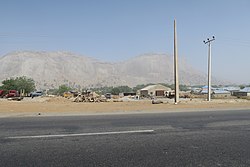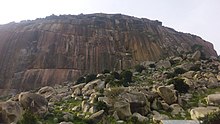Zamfara State
Zamfara جهار زمفر | |
|---|---|
 | |
 Flag  Seal | |
| Nickname(s): Farming is Our Pride | |
 Location of Zamfara State in Nigeria | |
| Coordinates: 12°10′N 6°15′E / 12.167°N 6.250°ECoordinates: 12°10′N 6°15′E / 12.167°N 6.250°E | |
| Country | |
| Date created | 1 October 1996 |
| Capital | Gusau |
| Government | |
| • Body | Government of Zamfara State |
| • Governor (List) | Bello Mohammed Matawalle (APC) |
| • Deputy Governor | Mahdi Aliyu Gusau (PDP) |
| • Legislature | |
| • Senators | C: Hassan Muhammed Gusau (APC) N: Sahabi Alhaji Yaú (APC) W: Lawal Hassan Anka (APC) |
| • Representatives | List |
| Area | |
| • Total | 39,762 km2 (15,352 sq mi) |
| Area rank | 7th of 36 |
| Population (2021 Census) | |
| • Total | 9,278,873[1] |
| • Estimate (2011) | 9,838,160 |
| • Rank | 11th of 36 |
| Demonym(s) | Zamfaran |
| GDP (PPP) | |
| • Year | 2007 |
| • Total | $4.12 billion[2] |
| • Per capita | $1,237[2] |
| Time zone | UTC+01 (WAT) |
| ISO 3166 code | NG-ZA |
| HDI (2018) | 0.415[3] low · 32nd of 37 |

Zamfara is a state in northwestern Nigeria. Its capital is Gusau and its current Governor is Bello Matawalle. Until 1996, the area was part of Sokoto State.
Zamfara is mostly populated with the Hausa and Fulani people. The Zamfarawa mainly in Anka, Gummi, Bukkuyum and Talata Mafara Local Governments areas. Gobirawa populated Shinkafi Local Government. Gobirawa actually migrated from the Gobir Kingdom. Burmawa are found in Bakura and Fulani peopled Bungudu, Maradun, Gusau and are scattered all over the State. In Chafe, Bungudu and Maru, most are mainly Katsinawa, Garewatawa and Hadejawa. While Alibawa peopled Kaura Namoda and Zurmi, while Alawan Shehu Usmanu Fulani Are Found in Birninmagaji.
It is bordered to the north by the Republic of the Niger, to the south by Kaduna State, to the east by Katsina State, and to the west by the states of Sokoto and Niger. It has a population of 9,278,873 according to the 2006 census and contains fourteen local government areas.
History[]
The people of Zamfara have over the years struggled for autonomy, but it was not until 1996 that the then military administration of the late General Sani Abacha detached the Zamfara State from Sokoto State with an area of 38,418 square kilometres. The first Governor was Jibril Yakubu.
The area today called Zamfara state was one of the old state like Kano, Katsina, Gobir, Kabi and Zazzau. The earliest inhabitants of Zamfara were said to have been hunters and giants.[4] They established their first settlement at Dutsi which was the first capital of Zamfara. It extends up to the bend of River Rima to the north west and River Ka in the south west. Zamfara Kingdom was established in the 11th century and flourished up to 16th century as a city-state. Its capital has shifted with the fortunes of the kingdom from place to place like Dutsi and Birnin Zamfara.
In the first half of the 18th century, its then capital Birnin Zamfara, was destroyed by the Gobir Kingdom and a new capital was established in Anka by the second half of the 19th century. Zamfara had many centers of commerce and scholarship that attracted many scholars like the Yandoto city. It became part of the Sokoto Caliphate after the 1804 jihad by Usman dan Fodio. In fact, Usman Danfodiyo settled in Sabon Gari where Sarkin Zamfara Abarshi had already established a garrison headquarters during the early days of his Jihad as a base from where fought Gobir and Kabi.[5]
At the wake of British colonialism, the emerging town of Gusau became an important commercial and administrative center with road and rail networks passing through it. With the creation of states during the Gowon Administration, Zamfara Kingdom became part of the then North West state and later the Sokoto State.[5]
Climate[]
The climate condition of Zamfara is tropical with temperatures rising up to 38 °C (100.4 °F) and above between March and May. Rainy season starts in late May to September while the mild season known as Harmattan lasts from December to April.
Local Government Areas[]
Zamfara State consists of fourteen (14) Local Government Areas. They are:
Demographics[]

Zamfara State is mainly populated by Hausa and Fulani people, with some members of Gwari, Kamuku, Kambari, , and Zabarma ethnic communities.[6] Others include the Igbo, Yoruba, Kanuri, Nupe and Tiv.
The state capital is an important commercial center with a heterogeneous population of people from all over Nigeria. As in all major towns in Nigeria, all the major towns in Zamfara have a large population of other peoples from different parts of Nigeria.
Languages[]
Hausa is the official language of the state. Other main languages spoken in Zamfara are English, French, Fulfulde, Arabic; minority populations also speak languages like: Yoruba and Igbo.
The Kainji languages C'Lela and Gwamhi-Wuri are spoken in Gummi LGA. Ut-Ma'in is also spoken in the state and in Kebbe, Sokoto State.[7]
Economy[]


Agriculture and gold mining are the main occupations of the people of the state and the central source of income. Irrigation is required for cereals and legumes hence its slogan "farming is our pride".[8]
The state is basically an agricultural state with over 80 percent of the people engaged in various forms of agriculture. Major agricultural products include millet, guinea corn, maize, rice, groundnut, cotton, tobacco and beans.[9]
Education[]
A list of tertiary institutions in Zamfara state include:
- Federal Polytechnic, Namo[10]
- Zamfara State University[11]
- Federal University Gusau[12]
Incidents[]
In 2009, gold mining became a greater source of income in Zamfara State as worldwide gold prices rose dramatically.[13] High concentrations of lead in the ore from which gold was being extracted led to a lead poisoning epidemic in the state, requiring national and international intervention to remediate affected areas and provide medical care to children with severe lead poisoning.
On 26 February 2021, 279 girls were abducted from their boarding school located in Jangebe, Zamfara during the Zamfara kidnapping. They have since been released.[14]
Religion[]
Islam is the principal and major religion of the state. Christianity also has many adherents. The original native religions also remain but they have the fewest followers. These religions are mainly practiced in ancient settlements like Dutsi and Kwatarkwashi. Zamfara was the first state in Nigeria to introduce Sharia law during the tenure of Ahmad Sani Yerima, the former Governor of the state.
Tourism[]

Zamfara State holds some number of tourist attractions which are of historical or religious importance. These include Jata, an ancient settlement of Zamfara located around the hill with a large cave around where traditional practices were performed.[9]
Notable people[]

See also[]
References[]
- ^ "2021 PHC Priority Tables – NATIONAL POPULATION COMMISSION". population.gov.ng. Archived from the original on 2018-01-14. Retrieved 2017-10-10.
- ^ a b "C-GIDD (Canback Global Income Distribution Database)". Canback Dangel. Retrieved 2008-08-20.
- ^ "Sub-national HDI - Area Database - Global Data Lab". hdi.globaldatalab.org. Retrieved 2018-09-13.
- ^ "Zamfara Gold Mining Factory". krzysztofpilarczyk.pl. Retrieved 2021-06-26.
- ^ a b "Zamfara State, Nigeria Genealogy". FamilySearch Wiki. Retrieved 2021-06-26.
- ^ "Nigeria Ethnic Groups|Map". onlinenigeria.com. Retrieved 2021-02-14.
- ^ "Nigeria". Ethnologue (22 ed.). Retrieved 2020-01-10.
- ^ "Zamfara gold mining: Niger Delta seeks amendment of petroleum, mining acts". December 12, 2020.
- ^ a b "Zamfara State of Nigeria :: Nigeria Information & Guide". www.nigeriagalleria.com.
- ^ "Official List of Courses Offered in Federal Polytechnic, Kaura Namoda (FEDPONAM) - Myschool". myschool.ng. Retrieved 2021-07-14.
- ^ "List of All Courses Offered at ZAMSU, Cut Off Mark & Requirements". Eduloaded. 2019-01-14. Retrieved 2021-07-14.
- ^ "List Of FUGUS Courses and Programmes Offered". www.myschoolgist.com. 2020-10-09. Retrieved 2021-07-14.
- ^ Maram Mazen (2012-05-10). "Nigeria Gold Rush Exposes Children to Lead Poisoning - Bloomberg Business". Bloomberg.com. Retrieved 2015-12-17.
- ^ "Nigeria's Zamfara school abduction: More than 300 Nigerian girls missing". BBC News. 2021-02-26. Retrieved 2021-02-28.
External links[]
- Zamfara State
- States of Nigeria
- States and territories established in 1996
- 1996 establishments in Nigeria

